The Grand Ole Opry (38 page)
Read The Grand Ole Opry Online
Authors: Colin Escott

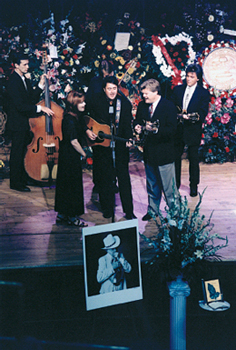
Roy Huskey, Jr., Patty Loveless, Vince Gill, and Marty Stuart bid farewell to Bill Monroe.
VINCE GILL:
He loved that music so much, and he created it. Who else can say that they defined a genre of music? It was Earl [Scruggs’]
banjo and much else, but he put it together, and that’s a prideful thing and he was a prideful man. But it comes back to the
songs, and they’re his songs. They’re the common denominator. “Can you play ‘Molly and Tenbrooks’ ”? “Can you play ‘Rose of
Old Kentucky’?” The legacy of great songs goes beyond his popularity as a singer. It’s like Hank Williams in that regard.
I sang at Bill’s memorial, and I was doing okay until the bagpipes played my song, “Go Rest High on the Mountain.” Then I
lost it. I didn’t know it was coming. I was so honored that a song of mine was played at his memorial.
Hank Snow died December 20, 1999, and at the beginning of the new century, Little Jimmy Dickens was the only regular remaining
cast member from the 1940s. The older generation was now the stars who’d come to the Opry in the 1950s, artists like Jimmy
C. Newman, Wilma Lee Cooper, Porter Wagoner, Stonewall Jackson, and Jean Shepard.
JEANNIE SEELY:
They changed the Opry in their day and we changed it with drums and violins and in other ways. Their Opry has gone away, and
now our Opry is going away because it’s supposed to be going away. It’s supposed to change, and it’s changing as it’s supposed
to change.
As the new century dawned, country music was second only to rock as the most popular type of music in the United States, but
once again the landscape was changing. Online radio, satellite radio, and music downloads were on the near horizon, changing
an industry that once thought solely in terms of analog radio and records. Again, the Opry had to adapt or risk obsolescence.
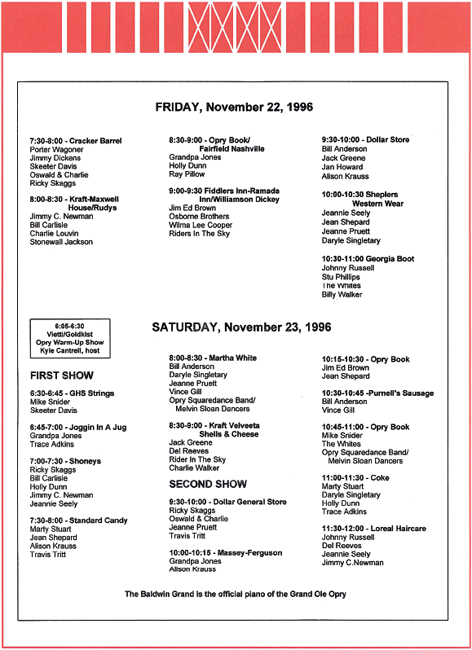
G
RAND
O
LE
O
PRY
NEW MEMBERS: 1990s
C
LINT
B
LACK
G
ARTH
B
ROOKS
B
ASHFUL
B
ROTHER
O
SWALD
(Pete Kirby)
D
IAMOND
R
IO
J
OE
D
IFFIE
V
INCE
G
ILL
A
LAN
J
ACKSON
H
AL
K
ETCHUM
A
LISON
K
RAUSS
E
MMYLOU
H
ARRIS
M
ARTINA
M
CBRIDE
J
OHNNY
P
AYCHECK
C
HARLEY
P
RIDE
MIKE
S
NIDER
M
ARTY
S
TUART
T
RAVIS
T
RITT
S
TEVE
W
ARINER
T
RISHA
Y
EARWOOD
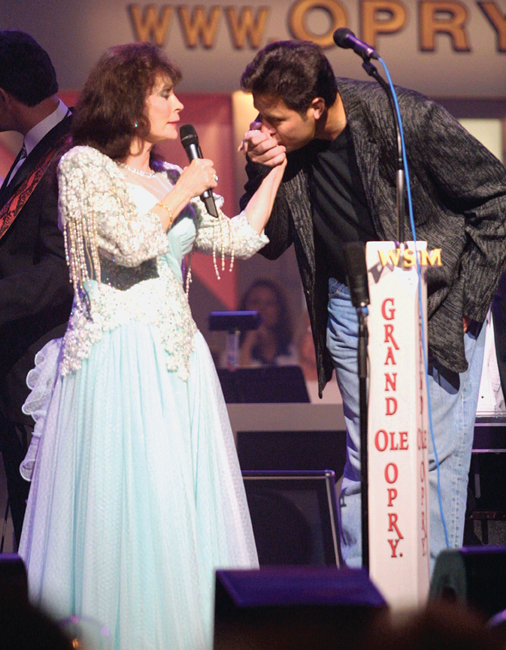
FACING THE FUTURE
I
n the mid-1970s, the chance of Nashville’s seedy downtown core being reborn looked no brighter than the Ryman’s chance of
avoiding the wrecker’s ball, but by the late 1990s, weekend crowds thronged downtown as they had in the 1940s. Jo Mielziner,
the theatrical designer who’d called for the Ryman to be demolished, died in 1976 and didn’t live to see the Ryman become
not only a centerpiece of Nashville’s downtown renewal but one of the country’s premier live-music venues. Even the Grand
Ole Opry returned there for limited runs.
STEVE BUCHANAN,
president of the Grand Ole Opry Group:
The Ryman had been open for daily tours and there were some segments of television shows and movies shot there. In 1991, Emmylou
Harris recorded an album at the Ryman with a small audience and it really got people thinking about what we could do with
it. Then, in 1992, we staged a special performance to celebrate the one hundredth anniversary of the Ryman, again with a relatively
small audience. It was a magical night with performances by Emmylou Harris, Vince Gill, Ricky Skaggs, Bill Monroe and Connie
Smith. It reminded everyone of what an extraordinary place the Ryman is to hear live music. At the same time, the city was
starting to focus on downtown redevelopment, so the time seemed right to bring the Ryman back to life.
Passing it on. Vince Gill and Loretta Lynn, August 18, 2001.
RICHARD BENNETT,
coproducer of Emmylou Harris’s
At the Ryman:
The safety code meant that total admissions were restricted to something like two hundred a show, and we planned out the set
list and recorded the same set three times in three days. All the reverb is natural there. It’s just a marvelous room for
recording. I think everyone had forgotten just how good.
EMMYLOU HARRIS,
liner notes to
At the Ryman:
It’s more than the size and shape of that cornerless room. More than the wood used to build the curve in the Confederate Gallery,
and more than the distance that a bass note has to travel to hit that back wall with those stained glass windows where the
light sometimes came streaming in to illuminate the heart and soul of it all. It’s the hillbilly dust.
MARY HANCE,
journalist:
Opryland’s parent company, Gaylord Entertainment, invested more than $1 million [eventually $8.5 million] in 1989–1990 to
clean, stabilize, and restore the exterior of the Gothic structure and re-roof the Ryman Auditorium. The renovation and expansion
(the construction of a 14,000 square foot support building on the north side) is set for completion by June 1994, in time
for Fan Fair. The project will return the revered auditorium as a performance venue with 1,500 seats instead of the original
3,200. [The final capacity would be just over 2,300.] The total Ryman site size has tripled to 1.1 acres with the land Opryland
is purchasing through the Metro Development and Housing Agency.
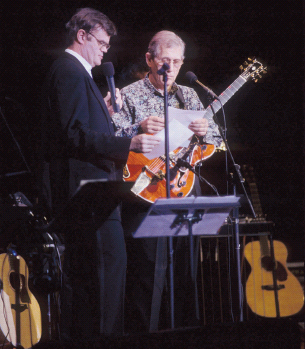
Garrison Keillor and Chet Atkins on
A Prairie Home Companion
at the Ryman. Keillor would eulogize Atkins at his funeral, held at the Ryman in 2001.
The official reopening was slated for June 4, 1994. The first show held there was Garrison Keillor’s
A Prairie Home Companion,
the radio program inspired by the last night at the Ryman twenty years earlier.
In January 1999, the Opry returned to the newly refurbished Ryman for a three-show run. The following year it spent all of
January there, and has since made the Ryman its winter home.
BILL ANDERSON:
From an artist’s point of view, it’s wonderful for the half hour or so that you’re onstage back at the Ryman. But then you
have to park across the street in good or bad weather. There are no lockers so you can’t leave your instruments or costumes
or anything. There’s not as many dressing rooms. But there’s something awfully magical about walking out onto that stage.
That said, after four months I’m ready to come back out to the new Opry House.
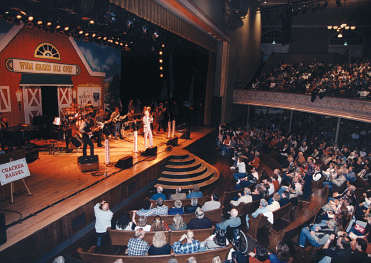
Porter Wagoner stars at theOpry’s return to the Ryman, 1999.
In January 1998, Opryland amusement park closed. In May 2000, the Opry Mills shopping mall opened on the site. The mall doesn’t
draw as many tourists as the park once did, and without the park as a “feeder,” the Grand Ole Opry now relies more heavily
upon its artists. At the same time, it has embraced new media, and in addition to its traditional home on WSM-AM, it can be
heard over the Internet and on satellite radio. Parts of the show are also seen on American Forces television and on Great
American Country cable television.
Hal Durham retired in 1996 and Bud Wendell in 1997. Bob Whittaker replaced Hal Durham. He’d joined the Opryland amusement
park in 1971 and produced shows for the park before moving to the Opry in 1993.
BOB WHITTAKER:
I was a frustrated singer, but no one ever paid a dime to hear me sing, nor should they. I think the music and the industry
dictate the changes at the Opry. It hasn’t lasted because some general manager came in and decided to do something. It has
lasted because we’ve been responsive to the industry and the fans.
We ask Opry members to do twelve appearances a year, but flexibility is the name of the game. Marty Stuart will walk in and
ask if there’s any room on the show. Vince Gill, too. One of the charms of the Opry is that it’s not a tightly formatted show.
Bob Whittaker retired in 1998, and the Opry is currently in the hands of Steve Buchanan, president of the Grand Ole Opry Group,
and Pete Fisher, vice president of the Opry Group and manager of the Grand Ole Opry.
PETE FISHER,
Opry vice president and general manager:
The legacy alone is motivation enough to make you want to do your best for the Opry. When I first came here, I didn’t want
to do anything that would evoke a reaction, like scheduling James Brown, but I’ve come to realize that the Opry is so diverse
that reaction is good. If people aren’t saying, “Well, I loved it,” “Well, I hated it,” then we’re losing some of the magic.
Just because we’re here to celebrate country music doesn’t mean that we always have to preach to the converted.